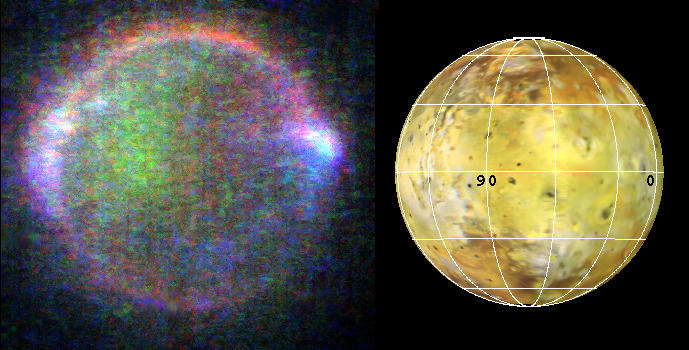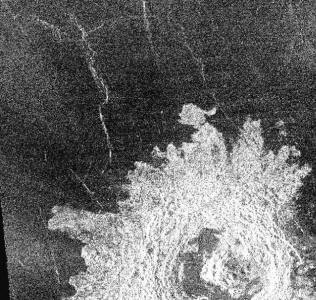|
The plasma sea in which the solar system floats extends out to what is called the heliopause - where there is probably a double layer that separates our Sun's plasma from the lower voltage plasma that fills our arm of the Milky Way galaxy.
In solar flares and coronal mass ejections (CME's), charged particles are thrown outward from the Sun. These flows constitute electrical currents. And what form do (Birkeland) currents take in plasmas? - They twist!
Interactions of Magnetotails The plasma sheath of Venus is extremely long, almost touching the Earth when the two planets are at their closest approach. Jupiter's plasma sheath has the same relationship with Saturn. Recently NASA astronomers have discovered what they call 'stringy things' in the long plasma tail of Venus. Such twisted (stringy) filaments are exactly the paths Birkeland currents take in plasmas.
Apparently Venus is discharging an electrical current. The plasma tails of all the planets today are in the dark current mode of operation. But were they always thus?
The ancients reported that Venus once was seen to have a fiery tail and 'twisted hair'.
Could it have been that her plasma tail was then in the normal glow or even the arc mode of operation?
So the Venusian tail is approximately a thousand times as long as it is broad at its thickest point. That is a very long, thin, twisting snakelike shape. If, at some time in the past, this plasma tail were in the normal glow mode, it would have been visible from Earth!
How would the ancients have described it? Intersecting Plasma Sheaths When a planet is surrounded by a double layer sheath, it is protected from direct electrical interaction with any outside body. Two electrically charged planets, each surrounded by such a plasma sheath cannot see each other electrostatically. However, if a body having a different electrical charge, penetrates the double layer, moving into the plasmasphere surrounding a planet, electrical interactions (current discharges) can and will occur.
Thus, if any other body such as a large meteor (or asteroid, comet, etc.) should come close enough to Earth to penetrate our plasma sheath, violent electric discharges would occur between the two bodies. It would, of course, be unfortunate to be standing at the point of origin of such a discharge.
But the discharge itself might destroy the intruder and thus protect the Earth from an otherwise disastrous collision.
NASA released the photo of Io shown below. Io is pretty much aglow. Note the heaviest glows on Io are on the sides directly toward and directly away from Jupiter. The famous 'volcanoes' on Io cannot be true volcanoes because they have moved around a distance of many miles since their discovery. Also the material ejected from the site of these phenomena is not disbursed over a circular area as volcanic ejecta would be.
It all
lands in a thin ring - just as the output of a plasma gun does.
These are clearly electric discharges, not volcanoes.
NASA recently directed the Galileo space probe to pass very close to one of the "volcanos" (electric arc discharges) on Io - with the following result (New Scientist October 30, 1999):
Flying a computer through a high intensity electric field is much more likely to "zap" its electronics than simply passing it no nearer than 380 miles distant from some smoke and molten rock.
The Grand Canyon of Arizona would be lost in one small section of it. There are many visible examples of electrical scarring on Mars. Electrical scars have characteristics that enable us to distinguish between them and water erosion and/or impact cratering.
Venus also
exhibits evidence of having been electrically machined.
They are made up of chains of craterlets.
This too is characteristic of electric arc machining (certainly not water flow). Notice the faint horizontal rilles crossing the large one. The horizontal rilles obviously were made later than the large rille. Notice too that the horizontal rille goes up hill and down hill, cutting right across the earlier structure.
Terraced crater walls and small secondary craters sitting on the edge of larger craters are characteristic of electric arc machining. Also notice the flat floors and almost perfect circularity of the craters. If the twisting arc that creates an electrically formed crater stops on the rim and does not extinguish, it will form a secondary crater.
This effect is clearly demonstrated in a
laboratory experiment shown on physicist Wal Thornhill's CD "The Electric Universe."
Sinuous rilles are one of the typical characteristics of electric arc machining. The standard mainstream explanation for these horseshoe shaped craters is that one side of the crater wall has collapsed.
What do you think? If all the "impact" craters on Mars, Venus, and our Moon were really formed by impacts, then probability would dictate that most (or at least a significant fraction) of them should be elliptical. Meteors very rarely come straight down. On the other hand, electric fields always impinge on conducting spheres at right angles to their surfaces (i.e., vertically) and that is why all these so-called circular "impact" craters are round.
They were not made by impacts.
They were caused by electric anode scarring.
But one of the official explanations is that,
Levitating??
And yet another property of Saturn's rings is that some of them are braided! They twist! The following is a quote from Science, Vol. 210, 5 Dec 1980, p. 1108:
Are the "braids" in Saturn's F ring due to just the kind of twisting currents that Birkeland observed?
|







